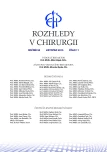Management of groin wound infection after arterial surgery using negative-pressure wound therapy
Authors:
M. Krejčí; R. Staffa; P. Gladiš
Authors‘ workplace:
II. chirurgická klinika, LF MU a FN u sv. Anny v Brně
přednosta: prof. MUDr. R. Staffa, Ph. D.
Published in:
Rozhl. Chir., 2015, roč. 94, č. 11, s. 454-458.
Category:
Original articles
Overview
Introduction:
Infection is a serious complication in vascular reconstructive surgery. When the entire graft is infected, its excision and subsequent replacement is the only option of treatment. In case of localised graft infection in the groin, the vascular reconstruction can be saved using negative-pressure wound therapy (NPWT).
Methods:
Retrospective study design was used to evaluate the efficiency of NPWT in the treatment of infected inguinal wounds following arterial reconstructive surgery. The assessments included demographic patient characteristics, causative agents, type of reconstruction and NPWT outcome. Wound infection was graded based on the Szilagyi classification. Patients were followed-up for 12 months after the therapy. Complete wound healing, retained graft patency, and no clinical signs or laboratory evidence of infection were regarded as successful results of treatment.
Results:
Between 2009 and 2012, 20 patients with deep groin infection (Szilagyi II and III) following arterial reconstructive surgery were treated by NPWT. The patient group included 12 men and 8 women; mean age was 68.1 years. Nine patients underwent aorto-femoral arterial reconstructions (with vascular prosthesis in 8 cases), and surgery below the inguinal ligament was done in 11 patients (with vascular prosthesis in 7 cases). Of the 20 patients, early infection within 30 days of surgery was recorded in 17 (85%) patients; Szilagyi grade III groin infection with exposed prosthetic graft was found in 5 (25 %) patients (infection: early, 4; late, 1). The causative agents isolated from the wound included Staphylococcus aureus (n=8), Pseudomonas aeruginosa (n=5) and Escherichia coli (n=5). Mean NPWT duration was 12.7 days. Wound healing was achieved in 17 patients (success rate, 85 %). Patients with early Szilagyi II infection showed the best outcomes (92.3%).
Conclusion:
Localised wound infection in the groin after arterial surgery is a serious complication of arterial reconstruction procedures. In eligible patients, such an infection can be treated conservatively using NPWT. The method is most efficient in the management of early infections. Wounds infected with P. aeruginosa or those with suture line exposure require special treatment. Long-term follow-up is necessary due to the risk of recurrent infection.
Key words:
negative − pressure wound therapy − vascular prosthesis − infection − groin
Sources
1. Szilagyi ED, Smith RF, Elliott JP, et al. infection in arterial reconstruction with synthetic grafts. Ann Surg 1972; 176:321−32.
2. Gastmeier P, Chaberny I, Hamann R, et al. Postoperative Wundinfektionen in der Gefässchirurgie. Surveillance als Basis für die Prävention. Gefässchirurgie 2003;8:85−91.
3. Diener H, Larena-Avellaneda A, Debus ES. Postoperative Komplikationen in der Gefässchirurgie. Chirurg 2009;80:814−26.
4. Kuy S, Dua A, Desai S, et al. Surgical site infections after lower extremity revascularization procedures involving groin incisions. Ann Vasc Surg 2014;28:53−8.
5. Exton RJ, Galland RB. Major groin complications following the use of synthetic grafts. Eur J Vasc Endovasc Surg 2007;34:188−90.
6. Suljagic V, Jevtic M, Djordjevic B, et al. Surgical site infections in a tertiary health care center: Prospective cohort study. Surg Today 2010;40:763−71.
7. Dosluoglu HH, Loghmanee C, Lall P, et al. Management of early (up to 30 day) vascular groin infections using vacuum-assisted closure alone without muscle flap coverage in a consecutive patient series. J Vasc Surg 2010;51:1160−6.
8. Staffa R, Kříž Z, Vlachovský R, et al. Autogenous superficial femoral vein for replacement of an infected aorto-ilio-femoral prosthetic graft. Rozhl Chir 2010;89:39–44.
9. Beno M, Martin J, Sager P. Vacuum assisted closure in vascular surgery. Bratisl Lek Listy 2011;112:249−52.
10. Saleem BR, Meerwaldt R, Tielliu IFJ, et al. Conservative treatment of vascular prosthetic graft infection is associated with high mortality. Am J Surg 2010;200:47–52.
11. Berger P, de Bie D, Moll FL, et al. Negative pressure wound therapy on exposed prosthetic vascular grafts in the groin. J Vasc Surg 2012;56:714−20.
12. Svensson S, Monsen C, Kölbel T, et al. Predictors for outcome after vacuum assisted closure therapy of peri-vascular surgical site infections in the groin. Eur J Vasc Endovasc Surg 2008;36:84−9.
13. Verma H, Ktenidis K, George RK, et al. Vacuum-assisted closure therapy for vascular graft infection (Szilagyi grade III) in the groin – a 10-year multi-center experience. Int Wound J 2013;12:317−21.
14. Pirkl M, Daněk T, Černý M, et al. Vakuová drenáž jako varianta terapie infektu cévní infraingvinální protetické rekonstrukce – zkušenosti z našeho pracoviště a shrnutí problematiky. Rozhl Chir 2013; 92:237−43.
15. Hiskett G. Clinical and economic consequences of discharge from hospital with on-going TNP therapy: a pilot study. J Tissue Viability 2010;19:16−21.
Labels
Surgery Orthopaedics Trauma surgeryArticle was published in
Perspectives in Surgery

2015 Issue 11
Most read in this issue
- Hepatic pseudolesions adjacent to the falciform ligament
- Our experience with the measurement of transcutaneous oxygen tension for evaluation of blood circulation in peripheral arteries in patients with critical ischemic disease of lower limbs
- Surgical therapy of pancreatic cancer – 5 years survival
- Management of groin wound infection after arterial surgery using negative-pressure wound therapy
